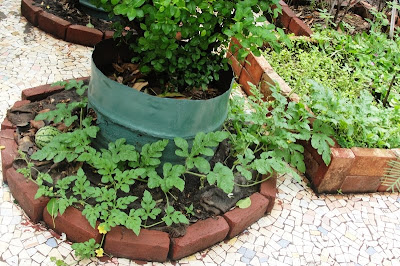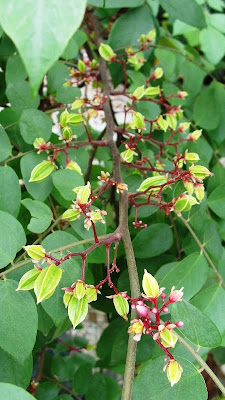Season started with a surprise of watermelon on the terrace... that too in a tiny place around the soil in a drum and planting and harvesting beans of various kinds.


.jpg)
.jpg)


.jpg)
.jpg)
.jpg)



















Experience of an urban farmer, experimenting on a terrace using Natueco methods of Farming.


.jpg)
.jpg)


.jpg)
.jpg)
.jpg)



















Q. How much water should be given to the plant?
Generally the requirement in Amrut Mitti is 1 ltr/sq ft in 10 days. Also Plants with big leaves loose more water due to transpiration and hence need more water. Ex Banana. plants like pomegranate need very less water.
Quantity also depends on the
· Humidity
· Temperature
· Microclimate
· Height of land
· Quality of soil
Q. When should one water?
Water the plants preferably after sunset.
Q. Which part of the plant should be watered?
Plant should be watered at the active feeder root zone, always away from the stem.
Every plant goes through five stages in its life
Childhood
Puberty
Youth
Maturity
Old age
Each of these phases is of equal duration.
External intervention like pruning, adding ash etc… is most productive when administered at the appropriate phase of growth.
For eg: there is no use adding ash to plant when it is in its last stage of growth.
Plants are classified in three categories according to their life span
1. Short duration : 90 – 130 days
2. Medium duration : 1 – 3 years
3. Long duration or perennials
In case of seasonal or short duration plants proper growth at all stages becomes critical. For ex : if root growth is not optimum in the first 15 to 20 days no amount of external inputs will be effective.
Leaves and branches also show these stages in their life cycles
NOTE:
The life of banana is 13 months.
Divide 13 by 5 = 2.6
Say three months
First three months of banana plant are the childhood phase.
During this time no photosynthesis takes place, and no food is prepared by plant.
This period is to be deducted during calculation of weight of dry matter prepared by plant during its life cycle.
So we consider 10 months.
Dry weight is that weight that remains constant after drying in sun ie; if we were to consider fresh bio mass, the same is called ‘fresh weight”. Allow this to dry under sun. Weigh it on alternate days. In span of 5 to 7 days when no loss of weight will be observed; that is dry weight.
Q How is this knowledge applied in understanding or calculating the yield of crop?
A. Through experiments and analysis it is understood that plants prepare 3 gms of dry matter/sq ft area of canopy. Out of this
1 gm is utilized by the plant in metabolism activities.
1 gm is uitilised for building branches, roots, leaves etc…
1 gm is uitilised for making fruits
So if we measure the canopy area, we can calculate the dry matter prepared by plant, and thereafter calculate the expected yield.
This knowledge also helps us understand the need of development of a proper canopy, which in turn depends on proper root growth arising out of a nutrient rich live soil.
Planting a sapling:
Choose a banana sucker for planting, weighing at least 600gms – 800gms
Choose a rhizome that has its first leaves like a sword and not flat.
Old roots should be cleaned and cut.
They should be soaked in Amrut Jal( Provide hyper link ) for 5 minutes.
They are smeared with wood ash and planted initially on bed of 20 ltrs Amrut Mitti (Provide hyper link) which is 9 inches high.
Observe the growth of banana carefully. Keep adding 20 ltrs of Amrut Mitti every month up to 5 months.
Keep making notes of
o Appearance and size of new leaves.
o Size of matured leaves (length and breadth after it is fully spread) date wise.
o Time table of addition of Amrut Mitti
o Height of stem
o Girth of stem
o Appearance of the flower.
o Conversion of flower into fruit
o Maturity of fruit and harvest time.
U will observe that it takes ten days for a new banana leaf to grow. Therefore in a month banana plant will have 3 new leaves. The life of every leaf is 5 months.
First few leaves are 1 sq ft area. Then as regular growth starts every new leaf is one and half or double the size of previous leaf. Maximum size of leaves is achieved before 4 months.
If you find this isn’t happening, look for reasons.
(less Amrut Mitti, less/more watering, etc… )
This goes on for 5 months.
So at end of 5th month, a healthy banana plant growing in 100 ltrs of Amrut Mitti has 15 matured leaves having canopy of about 25 sq ft area.
The life of each leaf is 5 months, hence after every 5th month 3 leaves die and 3 new leaves emerge.
Here onwards, every new leaf is of same size as the earlier leaf. And as one new leaf unfurls, the first leaf dries up to fall.
Never cut the leaves of banana plant before it dies on its own. While dying most of nutrients are sent back to mother plant for use for new growth or storage.
Formation of fruit:
Short duration plant gives fruit in 13 months and long duration plant in 18 months.
It is essential that the plant has all the 15 leaves from 5th month onwards or it does not produce optimum yield.
From 5th month onwards till the plant starts flowering the girth of the plant must go on increasing.
Normally we see lot of suckers of new plants growing around the plant. These should be cut and shifted to the nursery.
Only the sucker which grows in the seventh month; two months prior to flowering should be retained there. Suckers appearing after seventh month should also be shifted to the nursery.
When the plant is 5-6 (depending on variety) months old, the flowering process is complete within the plant
Half ltr of ash should be provided to the plant when it is 5 months old.
Harvesting Record yield:
Area of canopy of a matured plant is 25 sq ft.
On every sq ft area in India 3 gm/sq ft dry weight is produced.( add hyper link)
Out of this one gram is utilized by plant for its metabolism and two gms goes towards storage.
Out of these two gms one gm goes towards growth of roots, stem, leaves, etc…and one grm goes towards formation of fruit.
Now during childhood and old age of the plant ( pl refer to appendix for explanation ) no photosynthesis takes place.
Out of the life span of 13 months the plant is photosynthetically active for 10 months; after deducting three months of its childhood phase.
Now 2 grm / day of dry weight / sq ft area is utilized by plant for growth
ie: 2x25 sq ft = 50 gms/day
ie: 50 x 30 = 1500 gms / month
ie: 1500 x 10 = 15000 gms for ten months
= 15 kgs.
Now 50% of 15 kgs ie say 8 kgs will go towards formation of leaves, stem roots etc… a
And remaining 7 kgs will go towards fruit building.
Water content in fruit = 7x3times water= 21 kgs
So 7 + 21 = 28 kgs of total weight fruit can be harvested.
Add to it the weight of stem on which banana grows is 7 kgs.
So Total weight is 35 kgs.
Post harvest care
Post harvest the stem of banana plant should be cut, keeping one and half feet from the base. This provides nutrition to the baby plant.
The cut stem should be chopped in pieces and left on surface of mulch surrounding the small sapling, so that it decomposes and adds nutrition to growing plant




Now once planted in containers filled with Amrut Mitti following precautions should be taken.
Avoid over watering.
Care should be taken to see that we don't over water. Amrut Mitti has excellent water holding capacity and therefore, it is important to ensure that soil is moist and not wet.When saplings mature into trees, and Amrut Mitti is also 5-6 years old, we need to follow nature's cycle and monitor the watering accordingly.
Trees drop their leaves in winter and autumn. So be it on our farms. STOP WATERING. The Amrut Mitti harvests dew and takes up water for its needs from the atmosphere.
When grown from a graft
The saplings if grown from a grafted plant start giving fruits at an early date. As early as 8 - 10 months. It is important to understand that in case of grafted plants, the age of the plant from which it is grafted becomes the age of the sapling. And so the lifespan of these trees is also less.
Add Amrut Mitti proportionately to growth of canopy.

In case of guava plant check growth of branches on main branch, secondary branch and tertiary branch. In the secondary branch allow growth of leaves up to 10 nodes only. Beyond 10th node the plant will have only vegetative growth and there will be no fruit. Fruits will appear only between second and fourth node. So prune the stem at the 10th node. Pruning here will result in the sprouting of two more branches at this point. This helps in increasing canopy. Increased canopy results in increase in photosynthesis, and increase storage of food in stem. Same with the Custard apple tree. Results of pruning are that you will see fruits almost on every node of stem. :)
One can visualize that in nature , a herbivorous animal like goat will eat the lower branches which it can easily reach. The top branches, but those on the periphery were eaten by elephants, giraffe etc...Thus in nature pruning was done by animals ) However we do not have goats and other animals to do this job and therefore have to undertake it ourselves. The fallen leaves and the ones pruned should return back to our soil. Ensure that greens are not added directly in touch with soil, but on top of mulch. (In nature the greens eaten by animals, return to the soil through their dung! )
 Till about a year ago, we grew banana in half cut drums/containers filled with Amrut Mitti by following the regular Natueco method of planting a sapling.We got a yield of about 20 kgs of banana as against an yield of 35 kgs in Amrut Mitti heap on land.
Till about a year ago, we grew banana in half cut drums/containers filled with Amrut Mitti by following the regular Natueco method of planting a sapling.We got a yield of about 20 kgs of banana as against an yield of 35 kgs in Amrut Mitti heap on land.


